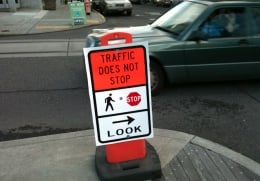
(not to mention, that’s the law).
Photo taken on Sunday in Portland’s Pearl District.
(Photo © J. Maus)
My friend (and Streetsblog founding editor) Aaron Naparstek sent along an unbelievable story that ran in the Washington Examiner today with the headline — Exercise, iPods could be causing pedestrian deaths.
The story is based on a new study by the Governors Highway Safety Association (GHSA) that tries to make sense of an uptick in the amount of people killed while walking in 2010.
Here’s an excerpt from the story (emphasis mine):
“GHSA executive director Barbara Harsha said her organization doesn’t know why there were more deaths… But the “get moving” movement, led by Obama’s “Let’s Move” campaign to eliminate childhood obesity, could be to blame, Harsha told The Washington Examiner…
There’s an emphasis these days to getting fit, and I think people doing that are more exposed to risk [of getting hit by a vehicle],” said Harsha, who conceded to having no scientific evidence that the Let’s Move campaign has led to an increase in walkers and runners, or deaths.
People are using more and more electronic devices — iPods and cell phones,” Harsha said. “They’re distracted and not paying attention to traffic and traffic signals, they’re stepping out in the street and getting hit.”
After several years of decline, the number of fatalities to people walking on our roads is on the way up. Here’s a snip from the GHSA press release that led to the Washington Examiner headline:
“While the slight increase may not seem particularly alarming, it is a concern given that during this same period overall traffic fatalities declined eight percent, according to the preliminary estimate from the NHTSA.”
That’s definitely a problem that merits concern. Here’s one of the culprits, according to the GHSA statement:
“A growing national focus on walkable communities and “get moving” health and fitness efforts may cause pedestrian exposur e, and thus risk, to increase.“
Here in Oregon, 2010 was the deadliest year in over half a century. 60 people were killed while walking on Oregon roads last year — after a low of 37 in 2009.
Oregon Department of Transportation (ODOT) Traffic Safety Division manager Troy Costales is Vice Chairman of the GHSA (we did a Q & A with him back in November). He offered this statement in their press release:
“It is definitely a concern. Looking at our data, we are seeing pedestrians crossing mid-block instead of at crosswalks, pedestrians walking in the roadway, and even some walking in the travel lanes of the interstate. We are familiar with aggressive drivers; we now have aggressive pedestrians.“
Everyone who uses our roads has a responsibility to use caution and follow the laws, but there’s clearly a narrative from some corners of the transportation world that seems to be oblivious to one of the main contributing factors to these deaths — roads engineered to move the most motor vehicles at the highest speeds possible no matter the cost to human life or livability in general. And it is not a coincidence that those who hold this view tend to work at agencies that place the highest priority on the dominant transportation paradigm of more cars, wider roads, and higher speeds.
Let’s not forget: Our roads are not owned by any one mode of travel; and if anyone has priority on them it should be those who are most vulnerable.
Given our recent battles with bad ideas making headlines, one quote from the GHSA spokesperson in the Examiner story stood out. “This is all speculative… Obviously, further study is needed.” Let’s see those studies and then let’s talk about sensible policy to address the issues.
The last thing a group truly concerned about traffic safety should do is take part in a PR campaign that blames victims, garners headlines that discourages the type of activity (walking) that we should all embrace, and that spreads completely speculative and dangerous ideas that clearly reinforce their own perspectives.

